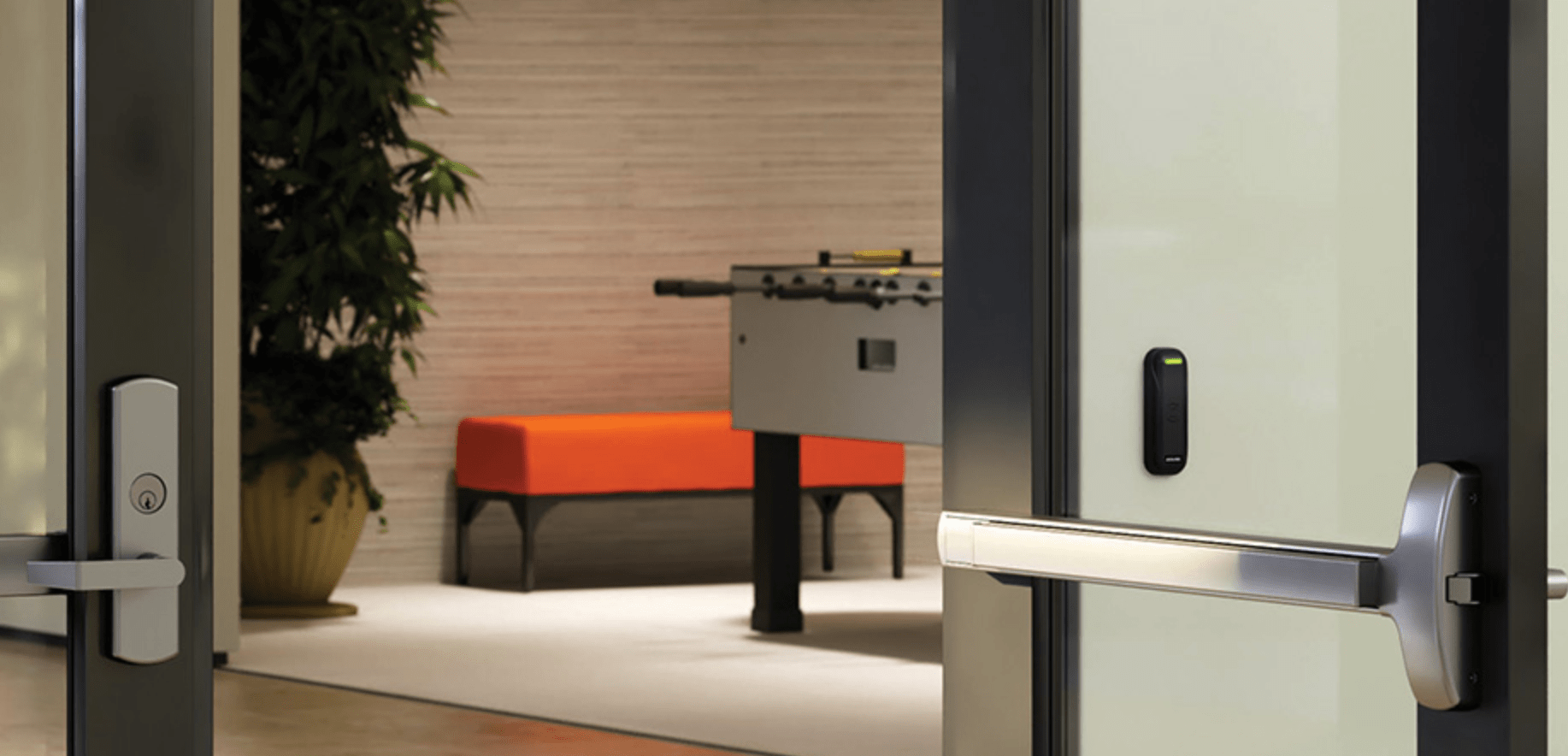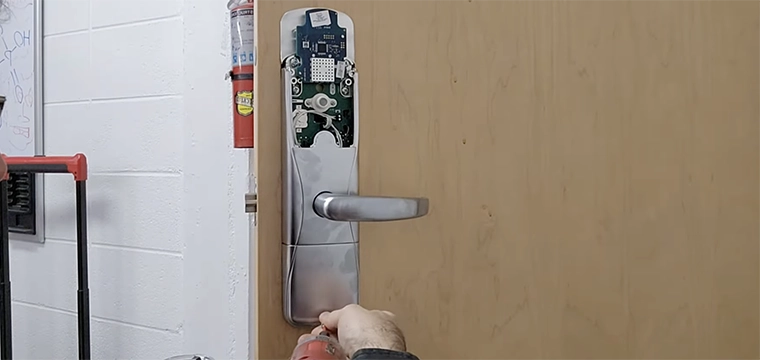
Planning ahead for post-coronavirus campus life
 By Robert Lydic, Vice President of Commercial Electronics Strategy, Allegion
By Robert Lydic, Vice President of Commercial Electronics Strategy, Allegion
Unprecedented times. Unfamiliar landscapes. We’ve heard it described many ways. The fact is that nearly every industry has had to face new challenges and pivot operations because of the COVID-19 outbreak.
Higher education is no different. Most universities and colleges closed earlier this year, moving to e-learning in many cases, creating unique pressure for students, their families and universities across the country.
While it’s unclear when schools will welcome back students, campuses need to be prepared for a new normal. There’s a lot of planning to be done while students are away. As your university develops plans to restart operations, you’re likely considering how to decrease opportunities for exposure.
In addition to following recommendations from the World Health Organization and Centers for Disease Control and Prevention (CDC), two solutions to think about are contactless credentials and touchless access control hardware. These measures can reduce the number of surfaces that people touch on campus and can help reduce contact transmission.
The future remains unclear. It’s hard to estimate what tomorrow holds because enrollment is unforeseeable at this time. Will schools continue e-learning for some or all of 2021? What does this mean for incoming freshman classes?
"Contactless credentials and touchless access control can help reduce the number of surfaces that people touch on campus and can help reduce contact transmission."
We’re dealing with this at home. My son was set to begin his freshman year of college this fall. He was accepted to several prestigious institutions, but COVID- 19 changed a lot for our family. It changed what school choices made the most sense because there are so many unknowns at this time.
Before coronavirus, we were debating over which school had the best program for his career, whereas now we are putting a bigger emphasis on location and costs. Do we send him to a phenomenal school out of state that costs more than double what an in-state school would cost? And would his campus experience even be what it would have been if he had started a year earlier?
My family isn’t unique. A survey by the Art and Science Group found that one in six high-school seniors who expected to attend a four-year college full time before the outbreak of the novel coronavirus now think that they will choose a different path this fall.
This ranges from taking a gap year to attending community college. According to the study, 35% of students said that campuses “closer to home” were now a more realistic option than their first-choice college. Additionally, about one-third of respondents said they were considering a less-expensive institution.
Even with so much out of the hands of universities, it’s still essential to focus on the road ahead. When it’s time to welcome students back to campus, schools will need to prove that they can offer a safe campus experience.
One place to start is by looking at things students touch daily on campus. How can those surfaces be more hygienic? Studies have found that viruses can survive on certain surfaces for days unless properly disinfected. As a result, facilities across the world are elevating their efforts to provide clean, safe environments.
The campus card is probably one of the most frequently touched items in a student’s wallet. Depending on your school’s one-card program, this credential might be used for access to buildings, dining halls, libraries and much more. Upgrading to a contactless solution limits the number of times a student needs to swipe a card, while improving security for your institution.
There are still colleges and universities that are using magnetic stripe technology for their campus card. Not only is this less secure than newer smart technology options, magnetic stripe isn’t contactless. Students touch their cards, swipe them through readers at places like dining halls then put them back in their wallets or pockets.
Proximity cards are contactless, but more secure technologies are available that are encrypted and less vulnerable to security breaches.
My recommendation for most schools is to consider mobile credentials. They’re contactless, which can help reduce contact transmission by decreasing the number of surfaces students touch on campus, thereby decreasing opportunities for exposure. They’re encrypted for added security. And they’re convenient for students, faculty and staff. Universities across the United States are already enjoying the benefits of mobile student IDs.
Mobile credentials allow for contactless deployment. Administrators in your one card office can push out credentials to students without requiring in-person interaction. This could dramatically decrease the amount of people stopping by your card office.
"Mobile credentials allow for contactless deployment, and your card office can push out credentials to students without requiring in-person interaction."
Think about the potential during orientation, whether that be this fall, next spring or beyond. A mobile credential option will make the process more seamless and sanitary.
Smart card technologies offer a similar contactless experience after deployment. Students will still need to receive a physical card, but from there, they can enjoy contactless transactions and access on campus.
Multi-technology readers can read both smart and mobile, so it’s easy for both forms to coexist on campus. Therefore, if your campus is transitioning to smart cards, consider the advantages of making the move to mobile.
Contactless credentials go far beyond access. These are essential for quick, in-and-out transactions. Think back to the dining hall example. Instead of swiping, a student presents his or her phone or Apple Watch near the reader — without coming in contact with it — and moves through the line. The phone goes back in a pocket or purse.
Credentials are just a piece of the puzzle in terms of access. When a student uses their phone for access, they often need to touch something to open the door after the reader verifies their credential. The same is true upon exit; a student will need to press the push bar for egress.
The less students need to touch a door, the better. To achieve this, consider these questions:
From libraries and rec centers to the main entrance of a residence hall, hands are coming in contact with openings all over campus hundreds of times a day, if not more. Touchless solutions can help reduce contact transmission by decreasing the number of surfaces people touch in a facility, which thereby helps decrease opportunities for exposure.
A common way to accomplish touchless operation is by pairing low-energy automatic operators with actuators or readers. Presenting a contactless credential to the reader can automatically open a door without an individual having to touch anything. A similar operation is performed when a person is leaving the building.
Solutions that keep people from handling a door are popular in many industries right now, and there is clear value for higher education campuses. In fact, I’ve found universities are already looking into contactless credentials that work with automatic operators and other hardware to create a more touchless campus.
"Touchless solutions can help reduce contact transmission by decreasing the number of surfaces people touch in a facility, which thereby helps decrease opportunities for exposure."
That said, adoption isn’t going to be uniform. Implementing a new credential platform requires a moderate investment, depending on the hardware that’s currently in place.
Your campus might need to upgrade readers to accommodate mobile credentials. Similarly, moving to touchless openings might require new hardware.
This is where the challenge comes full circle. Schools have been hit hard financially, so implementing new solutions isn’t feasible for all, at least not right now. But for schools who are in a financial position to manage these investments, there is value in taking a proactive approach to create a more hygienic environment.
Start looking for solutions that enable you to bring students back to campus in a safe fashion so they can return to the superior face-to-face instruction, in-person laboratory experiments and as much of a normal routine as possible, while, of course, practicing social distancing and other safety recommendations by the CDC.
There’s also long-term value to be considered. Incorporating contactless credentials will help a university to prepare for future technological advancements, improve security and create a more seamless campus experience.
Getting back to normal will take time. There’s a lot to be done to ensure your campus is a safe, clean environment for students. Moving to contactless credentials and touchless access control hardware won’t solve all of your challenges, but these are important considerations as you’re evaluating best practices during these uncertain times.
Whether students are welcomed back this fall, next spring or sometime after that, it’s going to be imperative that your school shows how it’s working to keep students safe. While campuses are free of students, I recommend using this time to focus on upgrades that promote a healthy environment, like a move to contactless credentials and touchless openings.




